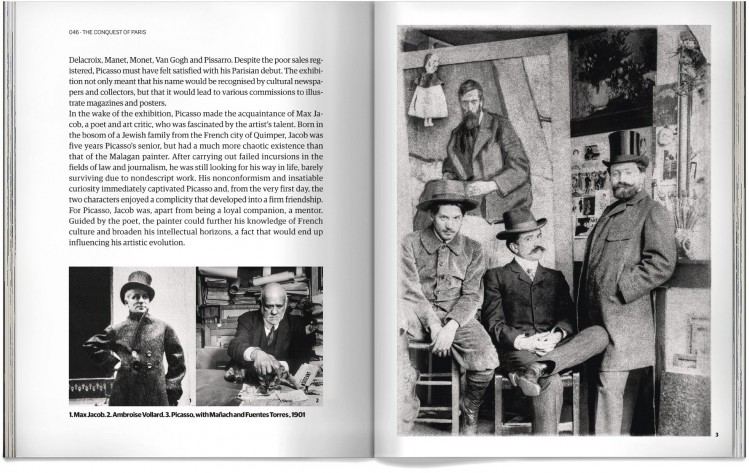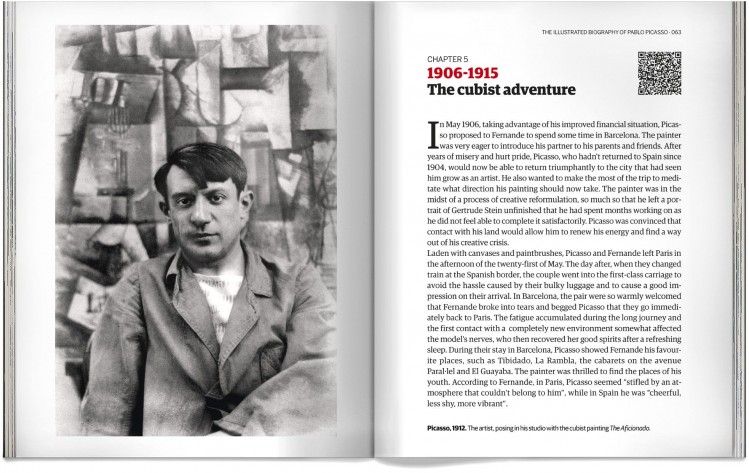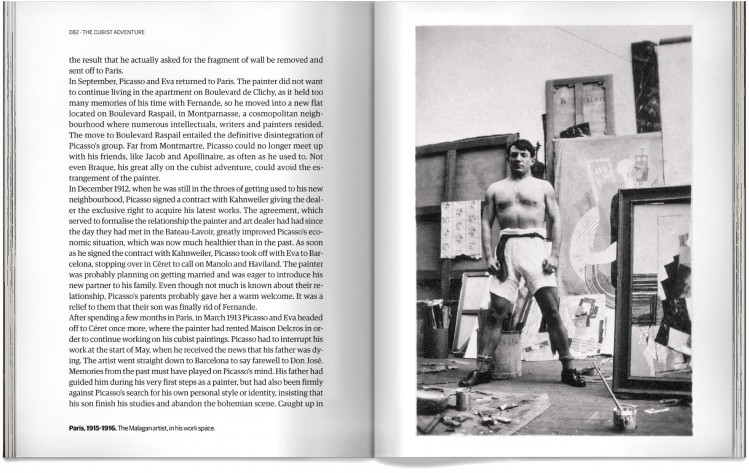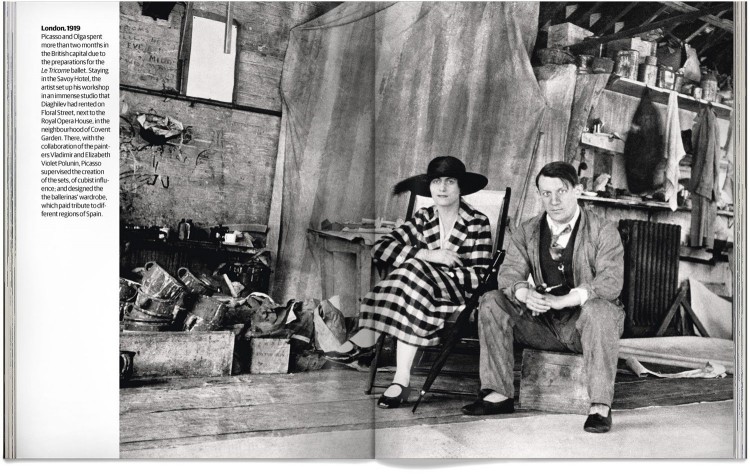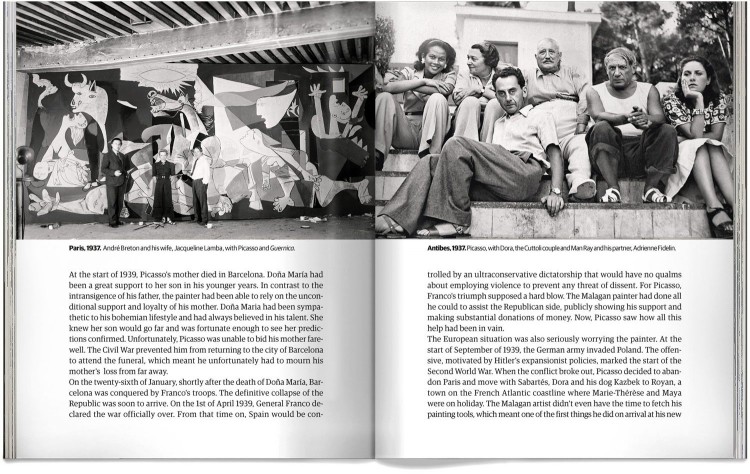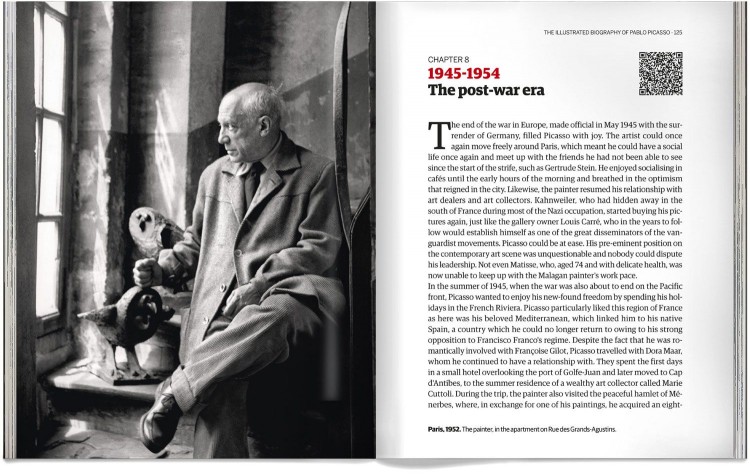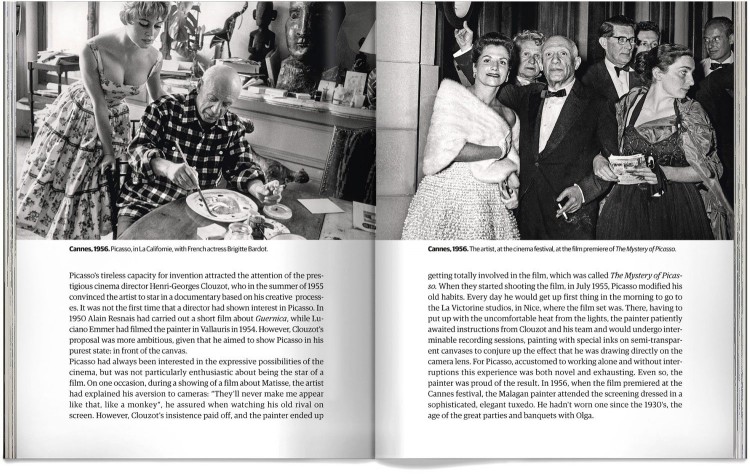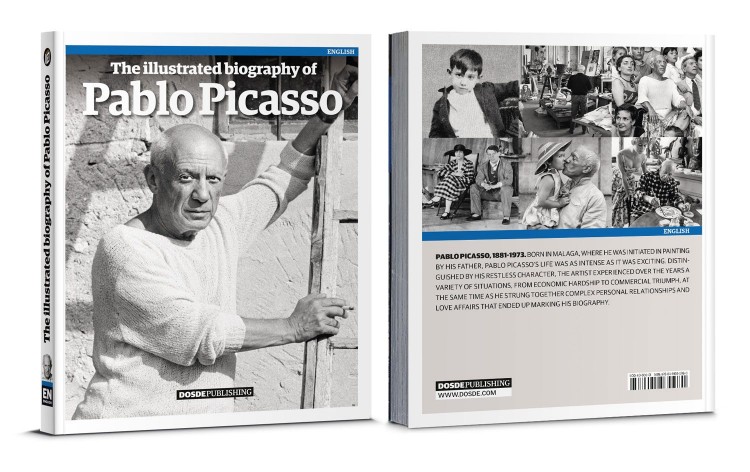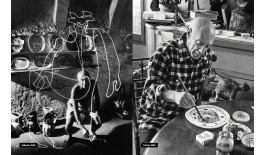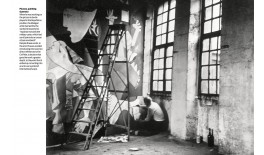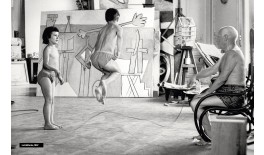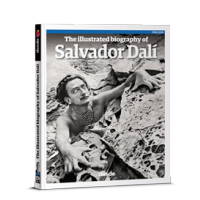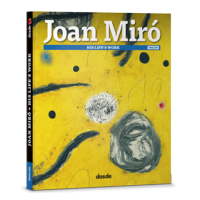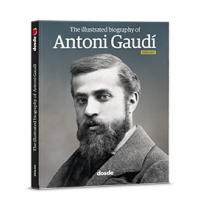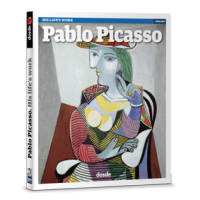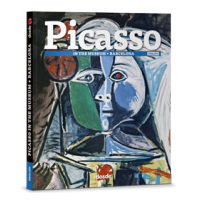The Illustrated Biography of Pablo Picasso
A complete testimony of his personal and professional life
RETURN
About the book Biography of Picasso
This biography on Pablo Picasso published by Dosde covers the career of one of the most important artists of all time. The book shows what events marked Picasso's life, as well as the personal relationships this internationally famous artist had over the years, whose artistic experiments marked the course of contemporary painting.
This biography on Picasso stands out for being a complete testimony of his life, both from a personal and professional point of view. In chronological order, the book carries out a detailed analysis of Picasso's trajectory, his artistic evolution and the situations that he faced throughout his intense life. This way, the reader can find out fascinating facts about Picasso and explore the genesis of his most famous works.
This book has been devised as an illustrated biography. This means that it includes a large number of historical photographs of Picasso's life. Its pages cover with maximum detail, both informatively and visually, the life of the great artist originally from Malaga. Due to its informative nature and the great amount of photographic documentation, it is one of the most complete books on Pablo Picasso published to date.
This biography on Picasso stands out for being a complete testimony of his life, both from a personal and professional point of view. In chronological order, the book carries out a detailed analysis of Picasso's trajectory, his artistic evolution and the situations that he faced throughout his intense life. This way, the reader can find out fascinating facts about Picasso and explore the genesis of his most famous works.
This book has been devised as an illustrated biography. This means that it includes a large number of historical photographs of Picasso's life. Its pages cover with maximum detail, both informatively and visually, the life of the great artist originally from Malaga. Due to its informative nature and the great amount of photographic documentation, it is one of the most complete books on Pablo Picasso published to date.
Visual Edition
The Illustrated Biography of Pablo Picasso
It includes exclusive digital content
Made with environmentally friendly paper
Official licensed product
Multilanguage: Available in 6 languages
About the book Biography of Picasso
This biography on Pablo Picasso published by Dosde covers the career of one of the most important artists of all time. The book shows what events marked Picasso's life, as well as the personal relationships this internationally famous artist had over the years, whose artistic experiments marked the course of contemporary painting.
This biography on Picasso stands out for being a complete testimony of his life, both from a personal and professional point of view. In chronological order, the book carries out a detailed analysis of Picasso's trajectory, his artistic evolution and the situations that he faced throughout his intense life. This way, the reader can find out fascinating facts about Picasso and explore the genesis of his most famous works.
This book has been devised as an illustrated biography. This means that it includes a large number of historical photographs of Picasso's life. Its pages cover with maximum detail, both informatively and visually, the life of the great artist originally from Malaga. Due to its informative nature and the great amount of photographic documentation, it is one of the most complete books on Pablo Picasso published to date.
This biography on Picasso stands out for being a complete testimony of his life, both from a personal and professional point of view. In chronological order, the book carries out a detailed analysis of Picasso's trajectory, his artistic evolution and the situations that he faced throughout his intense life. This way, the reader can find out fascinating facts about Picasso and explore the genesis of his most famous works.
This book has been devised as an illustrated biography. This means that it includes a large number of historical photographs of Picasso's life. Its pages cover with maximum detail, both informatively and visually, the life of the great artist originally from Malaga. Due to its informative nature and the great amount of photographic documentation, it is one of the most complete books on Pablo Picasso published to date.
Videos The Illustrated Biography of Pablo Picasso
Readers opinions
(2)
RETURN
Reviews
(2)
Totally recommended. I liked it because it tells you, through the photos, the life of Picasso in all areas: his work, his private life, his friends, influences, loves ... He is an artist that I have always admired, but I didn`t know so many things about him. With this book I totally discovered Picasso.
I liked the whole book, but the graphic documentation is wonderful. Many historical photographs of Picasso that I had not seen, is a book full of facts that I did not know about him. It was a wonderful gift. He was a great artist, unrepeatable.
Readers opinions
(2)
Totally recommended. I liked it because it tells you, through the photos, the life of Picasso in all areas: his work, his private life, his friends, influences, loves ... He is an artist that I have always admired, but I didn`t know so many things about him. With this book I totally discovered Picasso.
I liked the whole book, but the graphic documentation is wonderful. Many historical photographs of Picasso that I had not seen, is a book full of facts that I did not know about him. It was a wonderful gift. He was a great artist, unrepeatable.
Additional Information
- Additional Information
- Subtitle: A complete testimony of his personal and professional life
- Weight (g): 515
- Binding: Paperback
- Size (cm): 16,5 x 20,5
- Author: Dosde
- Pages: 0
- Edition: Visual Edition
Biography of Picasso
Pablo Picasso's work is closely linked to his personal life. His pictures reflect the numerous sentimental relationships he had over the years, many of them subject to controversy. Likewise, the Andalusian painter's work demonstrates how major events in history influenced his work, a man that was firmly committed to peace and social justice in times marked by wars and ideological tension.
Coming from a large, middle-class family from Malaga, the father was an unpromising painter who worked as a teacher in the School of Fine Arts and was also the curator of the municipal museum. Meanwhile, the mother, from whom Picasso inherited his extrovert character and physical constitution, was of Genoese origin on her father's side.
Despite the fact that the economic position of the Ruiz-Picasso family was quite modest, the family nonetheless continued to expand. Towards the end of 1884, Lola was born, followed by Conchita in 1887, whose death in 1895 would be one of the most dramatic episodes in Picasso's life.
They all resided in a third-floor apartment in a building in the Plaza de la Merced, a central part of Malaga, a city that at that time was undergoing a grave economic and social crisis owing to the decline in the steelmaking industry and the havoc caused by phylloxera in the viticulture sector.
Picasso's grandmother and his maternal aunts also lived in the apartment, as well as a servant, which meant that Pablo was accustomed to being surrounded by many female figures.
Sheltered by his home environment, Picasso had a placid childhood. At home, he would have fun playing with his small sisters, drawing and cutting out paper to create pictures of flowers, animals and people. In the street, his day to day was mainly spent in the Plaza de la Merced and its surrounding area, where he would run about with children of a similar age.
After residing four years in La Coruña in Galicia, in 1895 Picasso moved with his family to Barcelona. The future artifice of Cubism matriculated in the city's School of Fine Arts, and over time fell in with the local bohemian scene thanks to his constant incursions in the tavern Els Quatre Gats, one of the main centres for the dissemination of Catalan Modernism.
In Els Quatre Gats, Picasso learnt about the new cultural trends coming from the north of Europe, a fact that allowed him to considerably expand his own artistic repertoire. Likewise, in the Barcelonan tavern the artist coincided with other like-minded young people, such as the writer Jaume Sabartés, who years later would convert into his personal secretary, in particular, the painter Carles Casagemas, who would become his inseparable companion.
It was Casagemas who accompanied Picasso on his first trip to Paris. The two friends spent time in the French capital in 1900, which was transcendental for Picasso, who from then on would employ all his energy into penetrating the competitive Parisian art market. Despite the assistance of characters such as the art dealer Pere Mañach, who organised the painter's first exhibitions in the city, Picasso would still take time to achieve his goal.
Living in the Montmartre district and surrounded by prominent figures from the avant-garde scene such as the writers Max Jacob, Guillaume Apollinaire and André Salmon, the painter was immersed in a very stimulating environment that helped him to evolve artistically.
Likewise, at that time, the artist made the acquaintance of his first love, the model Fernande Olivier, with whom he embarked on a passionate and stormy relationship.
Olivier would be the privileged witness to the artistic experiments that would result in the creation in 1907 of Les Demoiselles d'Avignon, one of the key works in Picasso's biography. With this painting set in a brothel, the artist inaugurated Cubism, a movement that would mark a turning point in the history of art by presenting a new way of portraying reality.
Stimulated by his collaboration with the painter Georges Braque and backed by the art dealer Daniel-Henry Kahnweiler, Picasso would dedicate the following years to exploring all the possibilities of this new style, which at first would come up against the general incomprehension of the Parisian cultural scene.
The outbreak of the First World War in 1914 made Picasso even more isolated, who saw how some of his old friends were forced to go to the front or live in exile to avoid reprisals.
Picasso's situation became even more complicated with Eva's declining health. The painter's partner, who possibly had cancer or tuberculosis, had felt poorly for months, but in February 1915 she took a turn for the worse and had to be hospitalised.
There was nothing that the doctors could do to remedy the situation. On the 14th of December 1915, Eva passed away. Picasso had been preparing himself for months for the death of his sweetheart, but was nonetheless devastated. The artist was forced to rebuild his emotional life at the same time as he came to the end of his cubist adventure.
From 1916, Picasso started to mix with the writer Jean Cocteau and the businessman Sergei Diaghilev, director of the famous Ballets Russes company. Through them, the painter carried out his first forays into the world of dance and met the Ukranian ballet dancer Olga Khokhlova, whom he would then go on to marry in 1918.
The first years of marriage were particularly sweet for the painter, who was also receiving excellent reviews and was much better off financially. Picasso had converted into one of the most popular artists of the time, and European high society welcomed him with open arms.
Olga and Picasso's happy marriage, which led to the birth of the couple's only child, Paulo, was nonetheless short-lived. In 1927 the artist started seeing a woman 28 years his junior who was called Marie-Thérèse Walter, who in 1935 gave birth to the painter's first daughter, Maya.
This relationship, particularly fruitful on a creative level, led to great tension in Picasso's marriage, who ended up putting down on canvas his fraught mental state, with many of his works close to the postulates of the Surrealist movement.
Between the latter half of the 1930's and the first half of the 1940's, Picasso's biography was totally conditioned by wars. In 1936 the Spanish Civil War broke out, whose attrocities were condemned by the painter in his masterpiece Guernica, and three years later the Second World War started, an episode that plunged the European Continent into one of its darkest periods.
The German occupation of Paris obliged Picasso to take refuge in his painting, which took on a more expressionist style as a reflection of the anguish of this period.
As for his love life, these years of political and social instability are linked to the name of the Surrealist photographer Dora Maar, whose strong personality immediately captivated Picasso who was still at the time in close contact with Marie-Thérèse Walter.
Just before the end of the war, Maar would be replaced by the artist Françoise Gilot, with whom Picasso would have two children, Claude and Paloma, born in 1947 and 1949 respectively.
The post-war period was also marked by his time spent in the French municipality Vallauris, where Picasso became fascinated by the world of pottery, and towards a vitalist style inspired by the Mediterranean and mythology, demonstrated in works by Picasso such as La Joie de vivre.
This situation became so unbearable that Picasso ended up abandoning Paris to settle in the south of France, where it was easier to go unnoticed. Leaving Paris supposed the distancing of Picasso from the most avant-garde circles, but this did not prevent the painter from evolving. Themes inspired by the great masters of painting started to be his new obsessions, as is demonstrated by his variations on Las Meninas by Velázquez.
During this period, Picasso's companion was Jacqueline Roque, whom the painter would marry in 1961. After living in Cannes and Vauvenargues, the couple definitively settled in the small town of Mougins. There, the artist would spend his final years, which were marked by public tributes and international exhibitions.
Picasso died on the 8th of April, 1973, aged 92. The painter was buried in the castle of Vauvenargues, in a private ceremony which was attended by Jacqueline, Paulo and a reduced group of friends. A discreet farewell for one of the most famous artists of the 20th century, a genius and visionary that had managed to change the history of art.
Picasso's first years
Picasso was born in the city of Malaga, one of the most important cities in the south of Andalusia, on the 25th of October 1881. He was the first-born child of a married couple called Don José Ruiz Blasco and Doña María Picasso López.Coming from a large, middle-class family from Malaga, the father was an unpromising painter who worked as a teacher in the School of Fine Arts and was also the curator of the municipal museum. Meanwhile, the mother, from whom Picasso inherited his extrovert character and physical constitution, was of Genoese origin on her father's side.
Despite the fact that the economic position of the Ruiz-Picasso family was quite modest, the family nonetheless continued to expand. Towards the end of 1884, Lola was born, followed by Conchita in 1887, whose death in 1895 would be one of the most dramatic episodes in Picasso's life.
They all resided in a third-floor apartment in a building in the Plaza de la Merced, a central part of Malaga, a city that at that time was undergoing a grave economic and social crisis owing to the decline in the steelmaking industry and the havoc caused by phylloxera in the viticulture sector.
Picasso's grandmother and his maternal aunts also lived in the apartment, as well as a servant, which meant that Pablo was accustomed to being surrounded by many female figures.
Sheltered by his home environment, Picasso had a placid childhood. At home, he would have fun playing with his small sisters, drawing and cutting out paper to create pictures of flowers, animals and people. In the street, his day to day was mainly spent in the Plaza de la Merced and its surrounding area, where he would run about with children of a similar age.
Bohemian Barcelona
After residing four years in La Coruña in Galicia, in 1895 Picasso moved with his family to Barcelona. The future artifice of Cubism matriculated in the city's School of Fine Arts, and over time fell in with the local bohemian scene thanks to his constant incursions in the tavern Els Quatre Gats, one of the main centres for the dissemination of Catalan Modernism.In Els Quatre Gats, Picasso learnt about the new cultural trends coming from the north of Europe, a fact that allowed him to considerably expand his own artistic repertoire. Likewise, in the Barcelonan tavern the artist coincided with other like-minded young people, such as the writer Jaume Sabartés, who years later would convert into his personal secretary, in particular, the painter Carles Casagemas, who would become his inseparable companion.
It was Casagemas who accompanied Picasso on his first trip to Paris. The two friends spent time in the French capital in 1900, which was transcendental for Picasso, who from then on would employ all his energy into penetrating the competitive Parisian art market. Despite the assistance of characters such as the art dealer Pere Mañach, who organised the painter's first exhibitions in the city, Picasso would still take time to achieve his goal.
Paris and the Cubist adventure
After a period marked by Casagema's suicide and the economic hardships which on a creative level were reflected by the so-called Blue Period, in 1904 Picasso definitively moved to Paris.Living in the Montmartre district and surrounded by prominent figures from the avant-garde scene such as the writers Max Jacob, Guillaume Apollinaire and André Salmon, the painter was immersed in a very stimulating environment that helped him to evolve artistically.
Likewise, at that time, the artist made the acquaintance of his first love, the model Fernande Olivier, with whom he embarked on a passionate and stormy relationship.
Olivier would be the privileged witness to the artistic experiments that would result in the creation in 1907 of Les Demoiselles d'Avignon, one of the key works in Picasso's biography. With this painting set in a brothel, the artist inaugurated Cubism, a movement that would mark a turning point in the history of art by presenting a new way of portraying reality.
Stimulated by his collaboration with the painter Georges Braque and backed by the art dealer Daniel-Henry Kahnweiler, Picasso would dedicate the following years to exploring all the possibilities of this new style, which at first would come up against the general incomprehension of the Parisian cultural scene.
Turbulent times
In 1912, when he was still in the middle of his Cubist experimentations, Picasso put an end to his relationship with Fernande Olivier to embark on a relationship with Eva Gouel. The arrival of Gouel in Picasso's life coincided with the painter moving to the Montparnasse neighbourhood, far from bohemian Montmartre and his usual social circle.The outbreak of the First World War in 1914 made Picasso even more isolated, who saw how some of his old friends were forced to go to the front or live in exile to avoid reprisals.
Picasso's situation became even more complicated with Eva's declining health. The painter's partner, who possibly had cancer or tuberculosis, had felt poorly for months, but in February 1915 she took a turn for the worse and had to be hospitalised.
There was nothing that the doctors could do to remedy the situation. On the 14th of December 1915, Eva passed away. Picasso had been preparing himself for months for the death of his sweetheart, but was nonetheless devastated. The artist was forced to rebuild his emotional life at the same time as he came to the end of his cubist adventure.
Middle class life
From 1916, Picasso started to mix with the writer Jean Cocteau and the businessman Sergei Diaghilev, director of the famous Ballets Russes company. Through them, the painter carried out his first forays into the world of dance and met the Ukranian ballet dancer Olga Khokhlova, whom he would then go on to marry in 1918.The first years of marriage were particularly sweet for the painter, who was also receiving excellent reviews and was much better off financially. Picasso had converted into one of the most popular artists of the time, and European high society welcomed him with open arms.
Olga and Picasso's happy marriage, which led to the birth of the couple's only child, Paulo, was nonetheless short-lived. In 1927 the artist started seeing a woman 28 years his junior who was called Marie-Thérèse Walter, who in 1935 gave birth to the painter's first daughter, Maya.
This relationship, particularly fruitful on a creative level, led to great tension in Picasso's marriage, who ended up putting down on canvas his fraught mental state, with many of his works close to the postulates of the Surrealist movement.
The horror of the war
Between the latter half of the 1930's and the first half of the 1940's, Picasso's biography was totally conditioned by wars. In 1936 the Spanish Civil War broke out, whose attrocities were condemned by the painter in his masterpiece Guernica, and three years later the Second World War started, an episode that plunged the European Continent into one of its darkest periods.The German occupation of Paris obliged Picasso to take refuge in his painting, which took on a more expressionist style as a reflection of the anguish of this period.
As for his love life, these years of political and social instability are linked to the name of the Surrealist photographer Dora Maar, whose strong personality immediately captivated Picasso who was still at the time in close contact with Marie-Thérèse Walter.
Just before the end of the war, Maar would be replaced by the artist Françoise Gilot, with whom Picasso would have two children, Claude and Paloma, born in 1947 and 1949 respectively.
The postwar
After the Second World War, Picasso employed part of his energy to defend his political beliefs. The artist joined the French Communist Party, a decision that was harshly criticised, and he got involved in all types of projects associated with the Left, such as the International Congress of Intellectuals for Peace, celebrated in 1948, celebrated in 1948 in Poland.The post-war period was also marked by his time spent in the French municipality Vallauris, where Picasso became fascinated by the world of pottery, and towards a vitalist style inspired by the Mediterranean and mythology, demonstrated in works by Picasso such as La Joie de vivre.
The latter years
Towards the end of his biography, Picasso had to cope with his own fame, which started to overshadow his new creative achievements. Treated as a living legend, the artist was constantly harassed by the media and his admirers.This situation became so unbearable that Picasso ended up abandoning Paris to settle in the south of France, where it was easier to go unnoticed. Leaving Paris supposed the distancing of Picasso from the most avant-garde circles, but this did not prevent the painter from evolving. Themes inspired by the great masters of painting started to be his new obsessions, as is demonstrated by his variations on Las Meninas by Velázquez.
During this period, Picasso's companion was Jacqueline Roque, whom the painter would marry in 1961. After living in Cannes and Vauvenargues, the couple definitively settled in the small town of Mougins. There, the artist would spend his final years, which were marked by public tributes and international exhibitions.
Picasso died on the 8th of April, 1973, aged 92. The painter was buried in the castle of Vauvenargues, in a private ceremony which was attended by Jacqueline, Paulo and a reduced group of friends. A discreet farewell for one of the most famous artists of the 20th century, a genius and visionary that had managed to change the history of art.

